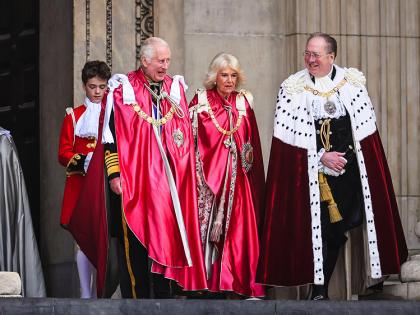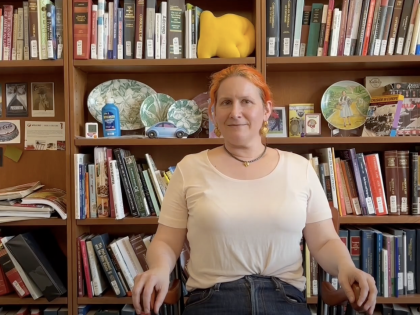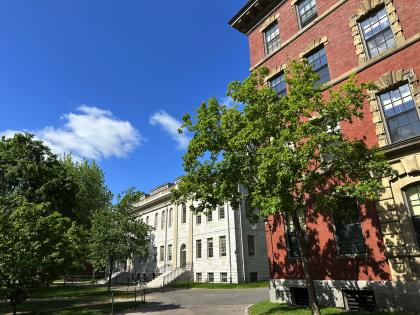And now for something completely different. Those readers who turned to this space in the previous issue found, under the headline Sensational, Shocking Tabloid Run by Harvard Grad!, a profile of the editor of the National Enquirer, class of '79. So let's not prevaricate. To bid for attention by implying that the annals of the Association of Harvard College Class Secretaries and Treasurers (AHCCS&T) might yield a few naughty bits would be insulting to the spirit of Veritas.
The late William Bentinck-Smith '37, one of the most devoted class secretaries to hold the office, barely cleared that ethical hurdle when he traced the association's history at the group's business meeting in 1985. "For a brief working title," he began, "I used for a while the term 'S-E-C-S Talk,' pronounced just as it looks. Although modish and catchy, this...seemed to promise too much." As a sound institutional historian, the former assistant to President Nathan Pusey recast his talk as "The Class Secretaries--Their History, Forms, and Use."
Marking their guild's hundredth year, almost a hundred secretaries and treasurers are expected to gather on March 10 for their annual meeting (ordinarily held in April), followed by a centennial dinner at the new Murr Athletic Center's "Hall of History." President Rudenstine will be the speaker.
Class secretary Anthony McAuliffe '80, principal planner of the event, vows that it will be memorable. Capital M. "Put rather crudely," he says, "it'll be like a corporation relaunching a product." If so, most class secretaries won't object to a bit of exposure. They're used to working in obscurity. Some of their own classmates wouldn't know their names, they're not the objects of Crimson exposés, and no one sends them roses on National Secretaries' Day.
Says Andrew Rudnick '69, current president of the AHCCS&T, "The College's alumni connect with one another, and with Harvard, primarily via periodic activities and events and continuing channels of published and electronic communications, established and maintained through the leadership of class secretaries and treasurers. That is an enormous responsibility, of vital interest to the institution, and it deserves greater recognition and support. I'm pleased that the hundredth anniversary can enable that to begin to happen."
The AHCCS (no T in those days) was formally organized in January 1901. But the role of secretary has a hoarier history. "The class secretary as a figure of importance in Harvard life seems to have emerged from the primeval ooze of the Cambridge marshes about the end of the eighteenth century," Bentinck-Smith suggested. The primordial function was social. "He was supposed to gather the class for some sort of festive meeting on Commencement Day. More usually, if we can believe tradition, the class secretary was a kind of bartender." As the Harvard Graduates' Magazine recalled in 1911, "In the old days...a Secretary was often chosen because he was a 'good fellow,' with a special knack for brewing punch. A corner of the cellar of the predecessors of well-known apothecaries in Harvard Square was consecrated to a group of demijohns, each labeled with a class numeral, and thither repaired, two or three times a year, venerable gentlemen, Secretaries of our fathers' and grandfathers' classes, to sample the concoction. On Commencement Day, at class reunions they dispensed their brew from punch-bowls of ample dimensions, and the test of their success was the rapidity with which they pleasurably but surely put their worthy classmates to sleep or sent them tottering to the Bowdoin Square horse-car...."
A relatively short-lived ban on Commencement punch "eliminated the need for such specialists," noted Bentinck-Smith, and the class secretary graduated from barkeep to keeper of the rolls. Typically, the office "fell to him who was thought most likely to be able to maintain records and addresses, encourage a modicum of good-fellowship and allegiance to Alma Mater, and be able to recognize a minority of his classmates at least by sight. But this scrivener's role was extraordinarily slow to develop."
The pace picked up in 1840, when an outpouring of institutional enthusiasm, generated by the College's bicentennial, led to the founding of the Harvard Alumni Association. Two years later the archivist and librarian John Langdon Sibley, A.B. 1825, started gathering biographical data about the College's earliest graduates, and in 1849 he adopted the practice of collecting current data from members of each graduating class. Seven years later, Sibley began delegating that task to class secretaries, providing them with "a series of questions as a basis for the autobiographies of the members." The responses, along with photographs or newspaper clippings that might come to hand, were folded into class albums, to be archived in the College Library once the last surviving class members had passed on. These "class-books" were the precursors of Harvard's anniversary class reports. Published at regular intervals since the 1890s, the reports have evolved into a singular art form that distinctively combines elements of Who's Who in America, the Almanach de Gotha, Tristram Shandy, the oral histories of Studs Terkel, and The Bold and the Beautiful.
Waldo Higginson, class of 1833, was the first secretary to publish both a twenty-fifth and a fiftieth anniversary report. As more reports appeared, it became clear that newer secretaries might profit from the experience of older ones, and that some degree of standardization might be in order. As Bentinck-Smith observed, "each secretary had to educate himself about the collection of material and its publication, and the almost total ignorance and innocence with which each entered upon his responsibilities led rather naturally to the suggestion that a formal fraternity of class secretaries could serve a useful purpose....The Association had its birth in a self-appointed committee consisting of Henry G. Denny 1852, William L. Richardson 1864, John T. Wheelwright 1876, Henry M. Williams 1885, and Arthur J. Garceau 1891. Tradition has it that Garceau, though still in his secretarial swaddling clothes, was the moving spirit behind the initial summons that brought a group of secretaries together on the afternoon of 27 November 1900, and eventually resulted in the formation of an Association of Harvard College Class Secretaries on 25 January 1901, with Wheelwright as chairman and Garceau as secretary."
Garceau was secretary of Harvard secretaries until 1938, when ill health forced him to retire. In Bentinck-Smith's words, "he helped raise and broaden the standards of our profession, and encouraged--in a University still innocently unaware or haughty about induced fellowship--a heightened consciousness of the virtue of alumni mortar between the Harvard bricks."
The early years of the AHCCS set an indelible pattern. At the annual dinners, veterans shared their accumulated wisdom with rising colleagues, and Harvard officers reported on the state of the College.
For almost half a century, each secretary handled most of the letter-writing, address-changing, editing, and proofreading for the class reports, unaided by copying machines, word processors, or computerized files. Pressure from the organized secretaries gradually brought a helpful alumni clerical bureaucracy into being. With administrative support from an Alumni Association staff that now numbers about 30 (and with the participation of class treasurers, whose organization was melded into the AHCCS in 1998), the association now observes old traditions even as it explores new horizons. At the annual dinner--a black-tie affair until the late 1950s --the oldest and youngest secretaries join the officers at the head table. The secretary of the twenth-fifth reunion class, as honorary chairman, selects the guest speaker, usually a classmate. Speakers have ranged from Harvard insiders like Hugh Calkins '45, a Corporation member at the time, and Graham T. Allison Jr. '62, Ph.D. '68, former dean of the Kennedy School of Government, to alumni in public life, like New Mexico Senator Jeff Bingaman '65 and U.S. District Court Judge Patti B. Saris '73 (whose appearance in 1998 was the first by a woman speaker).
Secretaries and treasurers are a durable bunch, though few have matched the lon-gevity of Professor Edward Kennard Rand, 1895, a classicist who regaled classmates with occasional poems composed in Latin. He stayed the secretarial course from graduation to his class's fiftieth reunion; that record was later eclipsed by Arthur Drinkwater '00, LL.B. '03, who died in 1978. In 58 years as class secretary, "Drinkie" ran more reunions and published more anniversary reports--including a seventy-fifth, when only six classmates were still on hand to read it--than any alumnus in history. Moving up on him now is Dan H. Fenn Jr., who's in his fifty-sixth year as secretary of the class of '44. The class of '45's secretary, Robert T.P. Storer Jr., has been on the job for 52 years; eight others have served four decades or more. Agewise, 98-year-old Lawrence Damon '24, who became class secretary in 1984, is the ranking member of the group. The all-time treasurers' record belongs to 99-year-old Sheridan Logan '23, now rounding out 77 years of service. At the youthful end of the spectrum are Dara Olmsted and Hector Bove, secretary and treasurer of the class of 2000.
The all-male cast of the AHCCS began to change in the 1970s, when Harvard and Radcliffe formalized coresidential housing. A dozen secretaries and six treasurers are women; the classes of '77 and '79 have male and female co-secretaries.
With the aid of the Wadsworth House staff, the AHCCS&T rides herd on members and sends out a punch list of "minimum standards"--i.e., contacting classmates at least once a year by letter or newsletter, arranging class events in nonreunion years, preparing quinquennial reports in reunion years, forwarding class notes to this magazine, and working with other officers to ensure that the class stays solvent. In recent years, the AHCCS&T has also worked to guide its members into cyberspace, assisting them in organizing class e-mail lists and providing tutorials for creating class Web pages. Thirty-three of the association's 75 secretaries currently post e-mail addresses in this magazine's class notes section; 19, from 1950 to 1999, have websites. Those proportions will inevitably increase.
The AHCCS&T, however, shows no signs of losing its sense of the past. Its new banner, to be unveiled at the centennial dinner, invests the Veritas shield with the ancient devices of quill and key. The legend http://www.haa.ahccs&t.harvard.edu/html is nowhere in evidence. ~"QUILL"







